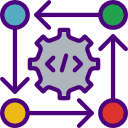The world of software development is experiencing a dynamic shift as no-code tools redefine what it means to build and launch applications. Modern developers are leveraging these platforms to accelerate innovation, maximize productivity, and democratize the development process. No-code solutions are empowering both technical and non-technical users to create robust digital products, streamline business workflows, and explore new ideas without traditional coding barriers. This page explores some of the groundbreaking no-code tools and how they are transforming the developer experience in today’s fast-evolving digital landscape.
Seamless App Building Without Code
No-code app builders are making software creation accessible to a broader audience, removing the barriers that once limited development to those with advanced technical skills. By providing an intuitive visual environment, these tools allow business analysts, entrepreneurs, and domain experts to bring their ideas to life independently. The democratization of development reduces project backlogs, empowers cross-functional teams, and accelerates time-to-market for new initiatives. As a result, organizations are able to cultivate innovation from within and adapt rapidly to market changes, all while reducing reliance on scarce developer resources.
Empowering Automation and Workflow Efficiency
Streamlining Business Operations
No-code automation platforms empower users to create efficient workflows tailored to unique business requirements. By connecting existing software solutions and orchestrating seamless data transfers between them, companies can reduce the time and effort spent on manual tasks. Eliminating repetitive actions not only saves valuable resources but also enhances overall accuracy and consistency. As businesses adopt these automation tools, they often experience significant gains in productivity and employee satisfaction, laying the groundwork for sustainable growth and innovation.

Fostering Collaborative Design
Visual development environments are inherently collaborative, providing teams with shared canvases where designers, developers, and stakeholders can work together in real time. By bridging communication gaps and enabling direct feedback on prototypes, these platforms minimize misunderstandings and accelerate consensus. The result is a more cohesive product vision, tighter alignment between teams, and streamlined iteration cycles that help deliver user-centric applications faster than traditional development methods.
Bridging the Gap Between Idea and Execution
Historically, translating business ideas into working software required lengthy specification and handoff processes between stakeholders and developers. No-code visual development tools eliminate this bottleneck by allowing non-developers to directly participate in building interactive prototypes or even fully functional products. This direct involvement reduces miscommunication, boosts innovation, and helps ensure that the final output truly aligns with the original vision. The seamless path from concept to execution means organizations can rapidly test and validate new market opportunities before making significant investments.
Customizing User Experiences with Flexibility
No-code visual tools offer unparalleled flexibility in designing customized user experiences. With a wealth of pre-built components and the ability to style every detail visually, teams can create tailored interfaces that resonate with their target audience. Dynamic behavior, responsive layouts, and personalized features can all be implemented without diving into complex frontend code. This flexibility helps businesses differentiate their offerings, adapt to evolving user needs, and deliver high-quality digital experiences that foster engagement and loyalty.
Join our mailing list
